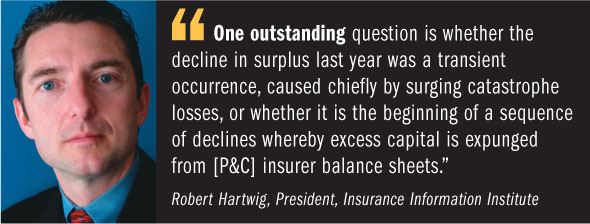The U.S. P&C industry in 2011 posted its worst combined ratio since 2001—and net income dropped more than 45 percent, according to a joint analysis conducted by three industry groups. But a separate report points to more profitable results in Q1 2012.
 In 2011, the industry's net income was $19.15 billion, compared to $35.2 billion in 2010, according to an analysis by ISO, the Property Casualty Insurers Association of America (PCI) and the Insurance Information Institute (I.I.I.).
In 2011, the industry's net income was $19.15 billion, compared to $35.2 billion in 2010, according to an analysis by ISO, the Property Casualty Insurers Association of America (PCI) and the Insurance Information Institute (I.I.I.).
Net-underwriting losses more than tripled to $36.5 billion from $10.5 billion, driving a 108.2 combined ratio.
“Poor underwriting results are particularly problematic in the current environment because of the toll that long-term declines in interest rates and investment leverage have taken on insurers' ability to use investment earnings to balance underwriting losses,” says Michael R. Murray, assistant vice president for financial analysis at ISO.
Catastrophe losses are primarily to blame for the underwriting losses. U.S. catastrophes caused $33.6 billion in direct-insured losses to all insurers before reinsurance recoveries, the analysis states. The losses are $19.3 billion more than in 2010, and $17.5 billion more than the 20-year average through 2011, according to ISO's Property Claim Services unit.
Coupled with an inability to use investment gains to offset underwriting losses, the P&C industry posted a 3.5-percent rate of return for 2011.
I.I.I. President Robert Hartwig says it was surprising to see how little surplus declined overall: Surplus was $550.3 billion at year's end, down just 1.6 percent from $556.9 billion at the end of 2010.
“One outstanding question is whether the decline in surplus last year was a transient occurrence, caused chiefly by surging catastrophe losses, or whether it is the beginning of a sequence of declines whereby excess capital is expunged from [P&C] insurer balance sheets as core underwriting losses mount and the ability to release prior-year reserves into the earnings stream diminishes,” Hartwig comments in a separate paper on industry results.
“The former seems to be the more likely case,” he adds, noting that results in 2011 would have been much worse had it not been for prior-year reserve releases.
Reserve releases increased to $11 billion in 2011 compared to $9.7 billion in 2010.
Surplus was down 4.6 percent at the end of the third quarter, but industry results during the last three months of 2011 recouped much of the decline.
Premium-to-surplus and loss-and-adjustment-expense-to-surplus leverage ratios are favorable.
“To the extent that these leverage ratios shed light on the amount of risk supported by each dollar of surplus, insurers appear to be extremely well capitalized at this point,” says Murray, adding the indicators “suggest that excess capacity in competitive markets may continue to limit rate increases and premium growth absent a significant capital event such as a major catastrophe or downturn in financial markets.”
In the fourth quarter of 2011, the industry benefited from an increase in premium growth. Hartwig says premium growth is on a sustained upward trajectory and could accelerate.
Net-written premiums in 2011 increased 3.3 percent from 2010. On a quarterly basis, premium growth has been positive since Q2 2010.
Looking forward to Q1 2012, global-investment bank Keefe, Bruyette and Woods (KBW) says in a report that it is raising its earnings-per-share estimates for many of the insurers and brokers it follows, noting that lower catastrophe losses are expected.
“The financial impact of catastrophes appears to have been relatively mild” in the first quarter, KBW says. Plus, many companies balanced reserves during Q4 2011 for catastrophes last year, so the firm expects “little noise from prior events.”
Rates are up in the mid-to-high single digits in U.S. commercial and low double digits in U.S. reinsurance sectors, KBW says. Increases are also seen in places that experienced larges losses in 2011, with flat rates to slight increases across most other lines.
However, benefits from reserve releases could decline in the first quarter, and low investment yields are ongoing, KBW adds.
For personal lines, rate increases in the 5-7 percent range are being seen in homeowner's. Increases are in the 2-3 percent range for auto, and KBW expects a premium growth rate of 5-7 percent.
KBW says earnings for Bermuda reinsurers will be aided by favorable renewals at Jan. 1, and there were few costly first-quarter catastrophes.
Turning to regional agencies and specialty carriers, KBW expects pricing commentary during first-quarter conference calls to be positive but is uncertain that rate increases will show up in reported premium growth.
Want to continue reading?
Become a Free PropertyCasualty360 Digital Reader
Your access to unlimited PropertyCasualty360 content isn’t changing.
Once you are an ALM digital member, you’ll receive:
- Breaking insurance news and analysis, on-site and via our newsletters and custom alerts
- Weekly Insurance Speak podcast featuring exclusive interviews with industry leaders
- Educational webcasts, white papers, and ebooks from industry thought leaders
- Critical converage of the employee benefits and financial advisory markets on our other ALM sites, BenefitsPRO and ThinkAdvisor
Already have an account? Sign In Now
© 2024 ALM Global, LLC, All Rights Reserved. Request academic re-use from www.copyright.com. All other uses, submit a request to [email protected]. For more information visit Asset & Logo Licensing.








